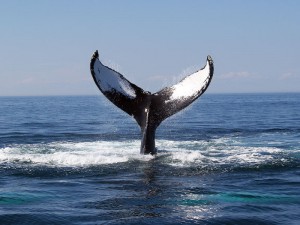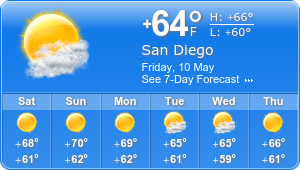Whale Watching
September 12, 2010 by admin
Filed under Sailing San Diego Bay
 Whale watching charters in San Diego are available for several months of the year. The type of whale we will see depends on the time of year.
Whale watching charters in San Diego are available for several months of the year. The type of whale we will see depends on the time of year.
Leave the zoos and aquariums behind, and see whales in their natural habitat! On our daily whale adventure tour from San Diego Bay, you’ll have a chance to see whales, dolphins, sea lions and birds of all kinds in their natural environment. Cruise alongside them from the comfort of a stable sailboat, and even take the helm yourself for a whale experience you will never forget!
Gray Whale watching is from Dec through March when the Gray whales are migrating past San Diego.
Blue whale watching is available from mid June to mid September. We generally have to go closer to the Coronado Islands or the Nine Mile Bank area to have a chance to see them.
Each year thousands of California Gray Whales make the long trek from their feeding grounds in the nutrient rich arctic waters to caving grounds in Baja, Mexico. The migration of approximately 10,000 km is thought to be the longest migration of any mammal.
The whales can reach a length of 52ft, a weight of 36 tons and an age of 60 years. The California Gray Whale for as large as they seem to us, is just a mid size whale. They get their name both from the gray slate color of their skin as well as from the gray-white patterns left by parasites. The California Gray Whale is classified as a baleen whale because it filters its food out from large quantities of sea water.
The Gray Whales were the first to be protected – beginning in 1937. There were historically 4 different populations, but only two have survived and only 1 population is healthy. Unlike most nature stories you may hear, the story of the California Gray Whale is considered a success story. Having been hunted almost to extinction, they have rebounded and now have an estimated population of 30,000 individuals.
Not only do we have the Gray Whales around San Diego, but it is also possible to see Orca (Killer) Whales, Blue Whales and others as well. Sighting of these are much rarer however.
Please take advantage of this wonderful opportunity to experience the grandeur of these magnificent creatures of the deep up close on your own private whale watching charter.
Gray Whales can reach a length of 52ft, a weight of 36 tons and an age of 60 years. The California Gray Whale for as large as they seem to us, is really just a mid size whale. They get their name both from the gray slate color of their skin as well as from the gray-white patterns left by parasites.
The California Gray Whale is classified as a baleen whale because it filters its food out from large quantities of sea water. It feeds on small crustaceans from the ocean bottom that it dislodges by rolling on it side. It them swallows the surrounding water and filters the nutrients out.
The gray whale has no dorsal (top) fin, but does have a dorsal hump about 2/3 of the way back on its body followed by a series of 6-12 knuckles along the dorsal ridge that extend to the flukes.
Gray whales reach sexual maturity sometime after 5 years of age. Their gestation period is around 12 months and after birth calves nurse 7-8 months on milk that is 53% fat (human milk is 2% fat). One calf is born per mother every couple years.
Breathing patterns are generally blowing 3-5 times in 15-30 second intervals before raising its fluke and submerging for 3-5 minutes. A gray whale can stay submerged up to 15 minutes.
Blue Whales
The Blue Whales are probably the largest animal to have ever lived on the planet – they are 70 to 100 feet in length, can weigh over 100 tons and have a distinctly blue color. They are also very fast swimmers and can swim at 30 knots if they choose.
It is strange that the largest animal on the planet eat almost exclusively small, shrimp-like creatures called krill – about 4 tons of them each day when feeding. Since these whale are baleen whales they filter the krill out from massive amounts of water.
They reach sexual maturity at a similar age to the gray whales and have a slightly shorter gestation period. During nursing (a period of about 7 months) the calf consumes 100 gallons of milk a day and gains about 200lbs/day in weight.
Today there are about 15,000 blue whales which is less than 5% of their pre-whaling population. They are found in all oceans of the world.
Orca (Killer Whales – Shamoo)
Most people are familiar with Orca Killer Whales becausee of Sea Worlds’s Shamou. They are about 30 feet in lenght and have a very distinctive dorsel fin which is several feet tall. They have teeth and feed on a variety of animals such as fish, porpoises and seals.
Orcas do migrate, but not on fixed routes and tend instead to follow food supplies. They have no natural enemies but are having health issues because of chemicals in the other animals which they consume. Their populations are worldwide.
Orcas seem to have no fixed breeding season as calfs are observed throughout the year. They reach maturity much later than other whale species, not until 10 to 18 years of age.
Interestingly the sounds of each Orca pod are unique.
There are Orca whales off Catalina, but we have not heard of them close
Finback Whale
They are second to the gray whale in size measuring in at around 80 feet with Fin Whalea weight of aroudn 60 tons. They are long and sleek and like the gray whale are fast swimmers. Being also a baleen whale they coral fish in tight circles before engulfing them.
The reproductive data is about the same as the other whales but they only breed each 3 – 4 years. They are found in all oceans of the world and migrate. Their populations is about 40,000 – a small percentage of their origional population.
Humpback Whale
Humpbacks whales measure around 45ft in length and weigh about 40 tons. They are more rotund and not as sleek as some of the other whales mentioned. The upper part of their body is black with the underside being white or mottled.
They are know best for 2 traits. First they are very acrobatic and exhibit behaviors like breaching or swimming on their back. The second trait is that of their song. The males sing songs that last for approximately 15 minutes that may repeat for hours at a time.
They feed on krill or small fish and filter it using baleen – eating up to 1.5 tons of food each year. These whales are found in all the worlds oceans. Their populations is around 35,000 – about 1/3 of their original population.
Whale Watching Cruises Run Dec Through March



